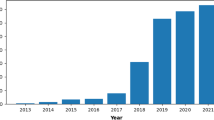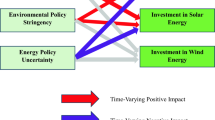Abstract
In the context of clean energy and green cryptocurrency development, the relationship between energy and cryptocurrency markets deserves further exploration. This study employs a quantile time-frequency connectedness approach to measure the dynamic connectedness and volatility propagation mechanisms between oil, clean energy, green cryptocurrency (GC), and non-green cryptocurrency (NGC) markets. Our findings suggest that, at median and low volatility levels, the oil and clean energy markets act as net receivers, taking on volatility spillovers from cryptocurrency markets. However, at high volatility levels, oil and clean energy markets transform into net transmitters. Most NGCs are volatility transmitters, while most GCs are volatility receivers in the median and extremely high volatility cases. We also observe that the total connectedness index (TCI) is heterogeneous over time and dependent on economic events. At median and low volatility levels, the short-run TCI makes the primary contribution. On the other hand, for high volatility levels, where short-term TCI does not have an absolute advantage, long-term TCI plays a greater role in many periods. Additionally, there is asymmetry in the TCI (including long-term and short-term TCI) at the quantile level. In the median and extreme scenarios, the COVID-19 has caused different levels of shock on oil, clean energy, GC, and NGC markets connectedness.

















Similar content being viewed by others
Availability of data and materials
The datasets analyzed during the current study are not publicly available, but are available from the corresponding author on reasonable request.
References
Ando T, Greenwood-Nimmo M, Shin Y (2022) Quantile connectedness: modelling tail behaviour in the topology of financial networks. Manag Sci 68(4):2401–2431
Anscombe FJ, Glynn WJ (1983) Distribution of the kurtosis statistic b2 for normal samples. Biometrika 70(1):227–234
Antonakakis N, Kizys R (2015) Dynamic spillovers between commodity and currency markets. International Review of Financial Analysis 41:303–319
Antonakakis N, Gupta R, Kollias C, Papadamou S (2017) Geopolitical risks and the oil-stock nexus over 1899–2016. Finance Res Lett 23:165–173
Attarzadeh A, Balcilar M (2022) On the dynamic return and volatility connectedness of cryptocurrency, crude oil, clean energy, and stock markets: a time-varying analysis. Environmental Science and Pollution Research pp 1–12
Baruník J, Křehlík T (2018) Measuring the frequency dynamics of financial connectedness and systemic risk*. J Financial Econometrics 16(2):271–296
Baruník J, Kočenda E, Vácha L (2016) Asymmetric connectedness on the U.S stock market: bad and good volatility spillovers. J Financ Mark 27:55–78
BenSaïda A (2019) Good and bad volatility spillovers: an asymmetric connectedness. J Financ Mark 43:78–95
Caporin M, Naeem MA, Arif M, Hasan M, Vo XV, Hussain Shahzad SJ (2021) Asymmetric and time-frequency spillovers among commodities using high-frequency data. Resources Policy 70(101):958
Chatziantoniou I, Gabauer D, Stenfors A (2021) Interest rate swaps and the transmission mechanism of monetary policy: a quantile connectedness approach. Economics Lett 204(109):891
Chatziantoniou I, Abakah EJA, Gabauer D, Tiwari AK (2022) Quantile time-frequency price connectedness between green bond, green equity, sustainable investments and clean energy markets. J Clean Prod 361(132):088
Chen J, Liang Z, Ding Q, Liu Z (2022) Extreme spillovers among fossil energy, clean energy, and metals markets: evidence from a quantile-based analysis. Energy Economics 107(105):880
Corbet S, Lucey B, Yarovaya L (2021) Bitcoin-energy markets interrelationships - new evidence. Resources Policy 70(101):916
D’agostino RB (1970) Transformation to normality of the null distribution of g1. Biometrika 57(3):679–681
Diebold FX, Yilmaz K (2012) Better to give than to receive: predictive directional measurement of volatility spillovers. Int J Forecast 28(1):57–66
Diebold FX, Yılmaz K (2014) On the network topology of variance decompositions: measuring the connectedness of financial firms. J Econom 182(1):119–134
Dong K, Hochman G, Zhang Y, Sun R, Li H, Liao H (2018) CO2 emissions, economic and population growth, and renewable energy: empirical evidence across regions. Energy Economics 75:180–192
Elliott G, Rothenberg TJ, Stock J (1996) Efficient tests for an autoregressive unit root. Econometrica 64(4):813–36
Fisher TJ, Gallagher CM (2012) New weighted portmanteau statistics for time series goodness of fit testing. J Am Stat Assoc 107(498):777–787
Forsberg L, Ghysels E (2006) Why do absolute returns predict volatility so well? J Financial Econometrics 5(1):31–67
Goodkind AL, Jones BA, Berrens RP (2020) Cryptodamages: monetary value estimates of the air pollution and human health impacts of cryptocurrency mining. Energy Res Social Sci 59(101):281
Guesmi K, Saadi S, Abid I, Ftiti Z (2019) Portfolio diversification with virtual currency: evidence from Bitcoin. International Review of Financial Analysis 63:431–437
Huang Y, Duan K, Urquhart A (2023) Time-varying dependence between Bitcoin and green financial assets: a comparison between pre- and post-COVID-19 periods. J Int Financial Markets Institut Money 82(101):687
Huyen NTT, Yen NH, Ha LT (2023) Could volatile cryptocurrency stimulate systemic risks in the energy sector? Evidence from novel connectedness models. Carbon Management 14(1):2184,719
Jareño F, delaO González M, López R, Ramos AR (2021) Cryptocurrencies and oil price shocks: a NARDL analysis in the COVID-19 pandemic. Resources Policy 74(102):281
Jarque CM, Bera AK (1980) Efficient tests for normality, homoscedasticity and serial independence of regression residuals. Econ Lett 6(3):255–259
Ji Q, Bouri E, Roubaud D, Kristoufek L (2019) Information interdependence among energy, cryptocurrency and major commodity markets. Energy Economics 81:1042–1055
Jiang S, Li Y, Lu Q, Wang S, Wei Y (2022) Volatility communicator or receiver? Investigating volatility spillover mechanisms among Bitcoin and other financial markets. Res Int Business Finance 59(101):543
Karim S, Lucey BM, Naeem MA, Uddin GS (2022) Examining the interrelatedness of NFTs, DeFi tokens and cryptocurrencies. Finance Res Lett 47(102):696
Khalfaoui R, Ben Jabeur S, Dogan B (2022) The spillover effects and connectedness among green commodities, bitcoins, and US stock markets: evidence from the quantile VAR network. J Environ Manag 306(114):493
Khalfaoui R, Mefteh-Wali S, Dogan B, Ghosh S (2023) Extreme spillover effect of COVID-19 pandemic-related news and cryptocurrencies on green bond markets: a quantile connectedness analysis. Int Rev Financial Analysis 86(102):496
Koop G, Pesaran M, Potter SM (1996) Impulse response analysis in nonlinear multivariate models. J Econom 74(1):119–147
Le TH (2023) Quantile time-frequency connectedness between cryptocurrency volatility and renewable energy volatility during the COVID-19 pandemic and Ukraine-Russia conflicts. Renewable Energy 202:613–625
Le TL, Abakah EJA, Tiwari AK (2021) Time and frequency domain connectedness and spillover among fintech, green bonds and cryptocurrencies in the age of the fourth industrial revolution. Technol Forecast Soc Chang 162(120):382
Liu J, Ma F, Tang Y, Zhang Y (2019) Geopolitical risk and oil volatility: a new insight. Energy Economics 84(104):548
Lu X, Huang N, Mo J, Ye Z (2023) Dynamics of the return and volatility connectedness among green finance markets during the COVID-19 pandemic. Energy Economics 125(106):860
Naeem MA, Karim S (2021) Tail dependence between bitcoin and green financial assets. Econ Lett 208(110):068
Naeem MA, Pham L, Senthilkumar A, Karim S (2022) Oil shocks and BRIC markets: evidence from extreme quantile approach. Energy Economics 108(105):932
Okorie DI, Lin B (2020) Crude oil price and cryptocurrencies: evidence of volatility connectedness and hedging strategy. Energy Economics 87(104):703
Pesaran H, Shin Y (1998) Generalized impulse response analysis in linear multivariate models. Econ Lett 58(1):17–29
Pham L, Karim S, Naeem MA, Long C (2022) A tale of two tails among carbon prices, green and non-green cryptocurrencies. Int Rev Financial Analysis 82(102):139
Pham LD, Huynh TLD, Hanif W (2021) Cryptocurrency, green and fossil fuel investments. IRPN: Innovation & Finance (Topic)
Rehman MU, Kang SH (2021) A time-frequency comovement and causality relationship between Bitcoin hashrate and energy commodity markets. Global Finance J 49(100):576
Rehman MU, Naeem MA, Ahmad N, Vo XV (2023) Global energy markets connectedness: evidence from time-frequency domain. Environ Sci Pollut Res 30(12):34,319-34,337
Ren B, Lucey B (2022) A clean, green haven?-Examining the relationship between clean energy, clean and dirty cryptocurrencies. Energy Economics 109(105):951
Ren B, Lucey B (2022) Do clean and dirty cryptocurrency markets herd differently? Finance Res Lett 47(102):795
Schinckus C (2021) Proof-of-work based blockchain technology and Anthropocene: an undermined situation? Renew Sust Energ Rev 152(111):682
Selmi R, Mensi W, Hammoudeh S, Bouoiyour J (2018) Is Bitcoin a hedge, a safe haven or a diversifier for oil price movements? A comparison with gold. Energy Economics 74:787–801
Shao L, Zhang H, Chen J, Zhu X (2021) Effect of oil price uncertainty on clean energy metal stocks in China: evidence from a nonparametric causality-in-quantiles approach. Int Rev Econ Finance 73:407–419
Sharif A, Brahim M, Dogan E, Tzeremes P (2023) Analysis of the spillover effects between green economy, clean and dirty cryptocurrencies. Energy Economics 120(106):594
Stiassny A (1996) A spectral decomposition for structural VAR models. Empirical Economics 21(4):535–555
Symitsi E, Chalvatzis KJ (2018) Return, volatility and shock spillovers of Bitcoin with energy and technology companies. Econ Lett 170:127–130
Tan X, Geng Y, Vivian A, Wang X (2021) Measuring risk spillovers between oil and clean energy stocks: evidence from a systematic framework. Resources Policy 74(102):406
Tiwari AK, Nasreen S, Hammoudeh S, Selmi R (2021) Dynamic dependence of oil, clean energy and the role of technology companies: new evidence from copulas with regime switching. Energy 220(119):590
Ulrich Gallersörfer LK, Stoll C (2020) Energy consumption of cryptocurrencies beyond Bitcoin. Joule 4(9):1843–1846
Umar Z, Polat O, Choi SY, Teplova T (2022) Dynamic connectedness between non-fungible tokens, decentralized finance, and conventional financial assets in a time-frequency framework. Pac Basin Financ J 76(101):876
Ustaoglu A, Yaras A, Sutcu M, Gencel O (2021) Investigation of the residential building having novel environment-friendly construction materials with enhanced energy performance in diverse climate regions: cost-efficient, low-energy and low-carbon emission. J Building Eng 43(102):617
Van Hoang TH, Shahzad SJH, Czudaj RL, Bhat JA (2019) How do oil shocks impact energy consumption? A disaggregated analysis for the US. The Energy Journal 40(The New Era of Energy Transition)
Wen H, Chen S, Lee CC (2023) Impact of low-carbon city construction on financing, investment, and total factor productivity of energy-intensive enterprises. The Energy Journal 44(2)
Wendl M, Doan MH, Sassen R (2023) The environmental impact of cryptocurrencies using proof of work and proof of stake consensus algorithms: a systematic review. J Environ Manag 326(116):530
Zeng T, Yang M, Shen Y (2020) Fancy Bitcoin and conventional financial assets: measuring market integration based on connectedness networks. Economic Modelling 90:209–220
Zhang B, Wang P (2014) Return and volatility spillovers between China and world oil markets. Economic Modelling 42:413–420
Zhang D, Chen XH, Lau CKM, Xu B (2023) Implications of cryptocurrency energy usage on climate change. Technol Forecast Soc Chang 187(122):219
Zhang M, Yang Z, Liu L, Zhou D (2021) Impact of renewable energy investment on carbon emissions in China - an empirical study using a nonparametric additive regression model. Sci Total Environ 785(147):109
Zhao L, He W, Wang A, Zhu F (2023) Time and frequency spillovers between the green economy and traditional energy markets. Systems 11(3):153
Funding
This work was supported by the National Natural Science Foundation of China (No.71871215), the Postgraduate Research Innovation Program of Jiangsu Province (KYCX23_2580), and the Graduate Innovation Program of China University of Mining and Technology (2023WLJCRCZL137).
Author information
Authors and Affiliations
Contributions
EZ: investigation, data curation, writing— original draft, writing—review and editing, visualization. XW: conceptualization, methodology, software, validation, formal analysis, writing—review and editing.
Corresponding author
Ethics declarations
Ethical approval
Not applicable
Consent to participate
Not applicable
Consent for publication
The authors give their consent to publish all submitted material.
Competing interests
The authors declare no competing interests.
Additional information
Responsible editor: Nicholas Apergis.
Publisher's Note
Springer Nature remains neutral with regard to jurisdictional claims in published maps and institutional affiliations.
Rights and permissions
Springer Nature or its licensor (e.g. a society or other partner) holds exclusive rights to this article under a publishing agreement with the author(s) or other rightsholder(s); author self-archiving of the accepted manuscript version of this article is solely governed by the terms of such publishing agreement and applicable law.
About this article
Cite this article
Zhou, E., Wang, X. Who are the receivers and transmitters of volatility spillovers: oil, clean energy, and green and non-green cryptocurrency markets. Environ Sci Pollut Res 31, 5735–5761 (2024). https://doi.org/10.1007/s11356-023-29918-3
Received:
Accepted:
Published:
Issue Date:
DOI: https://doi.org/10.1007/s11356-023-29918-3




